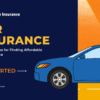Car insurance is a vital safeguard against the financial risks that come with owning and driving a vehicle. With a wide array of options and providers in the market, choosing the right car insurance can be challenging. To help you navigate the process, here are seven essential tips for selecting the best car insurance for your needs.
1. Understand the Different Types of Coverage
Before selecting a policy, it’s important to familiarize yourself with the various types of car insurance coverage available. Common coverage options include:
- Liability Coverage: Covers damages to others if you’re responsible for an accident.
- Comprehensive Coverage: Protects against non-collision-related damages, such as theft, natural disasters, or vandalism.
- Collision Coverage: Covers the cost of repairing or replacing your car if it’s damaged in an accident.
- Uninsured/Underinsured Motorist Coverage: Protects you if you’re in an accident with someone who doesn’t have sufficient insurance.
Knowing these options helps ensure you’re adequately protected based on your personal circumstances.
2. Compare Multiple Quotes
Insurance rates can vary widely between providers, so it’s crucial to shop around. Obtain quotes from at least three different insurance companies to compare rates and coverage options. Look beyond the price – make sure you’re comparing similar policies in terms of deductibles, coverage limits, and additional benefits.
3. Assess Your Coverage Needs
Your personal driving habits and the value of your vehicle should guide your insurance decisions. If you have an older vehicle, for example, you might not need comprehensive and collision coverage. On the other hand, if you frequently drive in high-traffic areas, extra coverage might be necessary for peace of mind.
4. Check the Company’s Reputation
It’s essential to choose a reliable and financially stable insurance company. Research customer reviews, and check ratings on reputable platforms like J.D. Power, AM Best, and the Better Business Bureau. A company’s track record for customer service and claims handling can give you insight into what you might experience as a policyholder.
5. Look for Discounts
Many insurance companies offer discounts that can help lower your premium. These can include:
- Safe driver discounts
- Multi-policy discounts (bundling auto and home insurance, for example)
- Good student discounts
- Discounts for safety features in your car (anti-theft devices, airbags, etc.)
Take advantage of any discounts available to reduce your overall costs.
6. Evaluate Deductible Options
A deductible is the amount you’ll pay out of pocket before your insurance kicks in. Generally, the higher the deductible, the lower the monthly premium. However, make sure your deductible is an amount you can comfortably afford in case of an accident or damage.
7. Read the Fine Print
Insurance policies are often filled with details and exclusions that may not be immediately apparent. Read the policy carefully to understand exactly what is covered, what’s excluded, and any conditions that apply. Knowing these details upfront can prevent surprises later when you file a claim.
Conclusion
Choosing the right car insurance requires careful consideration of your personal needs and thorough research. By understanding different coverage options, comparing quotes, assessing discounts, and reading the fine print, you can find a policy that offers the protection you need at a price you can afford. Stay informed, and make a choice that provides both financial security and peace of mind.
















